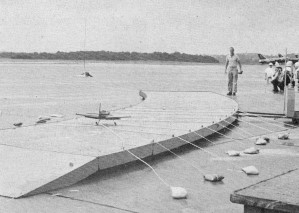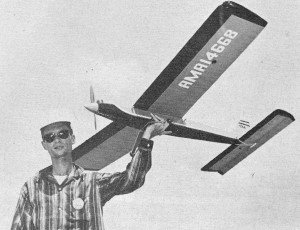|
An
extensive article introducing non-modelers to aircraft modeling appeared
in the Annual Edition of the 1962 American Modeler magazine. 15 pages were
devoted to describing just about every aspect of model building and flying
- free flight gas and rubber; control line stunt, combat, scale, and speed;
helicopters and ornithopters; indoor gliders, stick and tissue, and microfilm;
even some early radio control. In order to keep page length here
reasonable (because of all the images), the article is broken into a few
pages. Pages: |
10 & 11 |
12|
13
|
14 |
15
|16
|
17 |
18
|
19 |
20
|
21 |
22
|23
|
24 | For Non-Modelers: All About Air Modeling
20 Easy Ways to Go Crazy! <previous> <next>

You see? You need a big engine to start the small ones. Putt-putt powered
starter is for control line speed craft. Engine spinner is pushed against
rubber tube on end of shaft.

Carrier event control-line contender makes safe landing into arresting
gear stretched across curved deck.

Sleek radio controlled "pylon racer" uses 4-channel receiver-transmitter,
spans 66", weighs 4 pounds, has .19 cubic inch ·displacement engine
for power.
Such a model is the O.K. Cadet. The idea of a tethered or whip-powered model
is not new, but the OK Cadet goes a step further and puts a real power paint
in the nose of the model. This type of tethered model has. no movable control
surfaces and is properly balanced to fly straight and level with engine
running. The single flying line (15' of monofilament nylon line) is tied
to wingtip and fuselage at a point giving stable flying trim. By raising
or lowering the control stick (held by flyer at center of circle) some up
and down control is achieved. This control is necessary to counteract ballooning
(climb) going upwind, and sinking going downwind and to help control take-off
and landing. Another very good feature of the OK Cadet flying line stick
set-up is that the line can swivel and turn freely on the stick end. This
permits the flyer to stand still in the center of the flight circle and
let the model fly around him. This is important to beginning flyers because
spinning around in the center of the circle following the model can cause
dizziness. With the OK Cadet control stick .the flyer can stop turning if
he becomes dizzy, and simply hold the stick above his head until the dizziness
passes. The model will keep on flying. Somewhat more advanced than
the tethered OK Cadet, other engine-powered plastic flying models utilize
a standard control system and control handle set-up giving full elevator
control of the model. The elevator action works the same on a model as on
real aircraft. The control handle movement is transmitted to the model by
two flying lines. These are connected to a bellcrank which in turn is linked
to the elevators by a pushrod. Tilting the control handle top back gives
up elevator causing the model to climb, tilting handle top forward gives
down elevator causing dive. Most of the powered plastics use small "1/2
A" engines with .a displacement of about 0.049 cubic inch, and are flown
on 15 to 25' light Dacron lines so a clear circle of 50' plus diameter is
needed to avoid hitting obstructions. Areas such as school yards, public
parks or parking lots having smooth surfaces are needed to fly these control
line models. There are knock-apart powered plastic trainers ideal
for the beginner whose limited flying skill is bound to be rough on the
model. Other types are detailed scale copies of real aircraft both single
and twin-engined. Parts are injection molded plastic shells similar to those
used in non-flying plastic scales, but larger. Another innovation
in the powered plastic field is the molded foam plastic type. Models such
as the Sterling Mustang utilize this type of fabrication. The structure
is very light in weight, has a smooth finish, is impervious to glow fuels
and has excellent shock absorbing qualities. The latter being most important
to the beginner. Most powered plastics offer performance limited to take-off,
landing, and round and round flying. The Sterling Mustang is capable of
limited stunt flying. All of the powered plastic models are ready-to-fly
in the true sense of the word. The products include propellers, flying lines
and handles. Some come complete with fuel, plug wrench and battery wires.
A little simple knot tying, filling fuel tank and engine starting are all
that is needed to get them airborne. Dry cells for starting glow plug engines
are usually the only additional purchase involved. OUTDOOR
- After cutting his teeth on plastic scales, chuck gliders and an engine
powered plastic trainer, the young modeler can progress to building his
own. This is the turning point for most. He will either lose interest after
some moderate success with ready-to-fly models or continue into building
models from kits, later on from magazine plans, and perhaps from his own
designs. If he chooses to go ahead the modeler will find a wonderful world
of engines, balsa, cement, tissue, dope and high-flying model performance.
He will become (painlessly) a student of physics and aerodynamic theory,
a skilled craftsman and mechanic, in short a REAL modeler. <previous> <next>
Posted December 25, 2010
|



